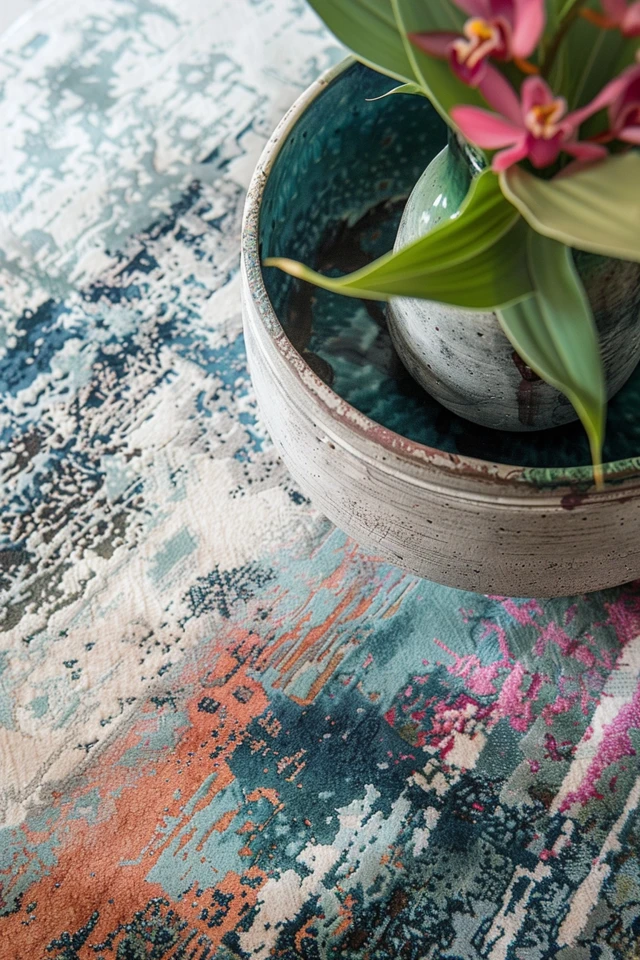If you have a rug that is stained or faded, I have good news for you! You can easily dye it using Rit Dye for a vibrant color transformation. One DIY method to dye a rug involves using Rit Dye, a popular fabric dye known for its vibrant colors and easy-to-use formula.
The dyeing process requires some basic materials such as liquid dye (Rit Dye is recommended), spray bottles, a sponge, rubber gloves, a water hose, and a vacuum. Before dyeing the rug, it is important to give it a thorough vacuuming and spot clean any grime or stains that may hinder the dye absorption.
For the dyeing process, choose the desired colors and mix the dye with water in separate spray bottles. Start with a base color and gradually add layers for an ombre effect. After spraying the dye, let it soak in for a few hours, then rinse the rug with a water hose to remove any residual dye. Once the rug is dry, give it a thorough vacuuming to ensure the fibers are lying flat. This process can be repeated for a more intense color or to achieve the desired result.
To prevent any bleeding, it is recommended to place a rug pad underneath the dyed rug. With these simple steps, you can transform your old, stained rug into a vibrant and colorful centerpiece for your space.
Key Takeaways:
- Dyeing a rug with Rit Dye is an easy DIY method for a vibrant color transformation.
- Before dyeing, vacuum and spot clean the rug to remove any grime or stains.
- Choose desired colors and mix the dye with water in separate spray bottles.
- Apply the dye in layers for an ombre effect and let it soak in before rinsing.
- Give the rug a thorough vacuuming once dry, and consider using a rug pad to prevent bleeding.

Tips for Successful Rug Dyeing
When dyeing a rug with Rit Dye, there are a few tips to keep in mind to ensure successful results. First, it is important to choose the right type of rug for dyeing. Natural fiber rugs such as cotton or wool tend to dye more easily compared to synthetic materials.
Before dyeing, make sure to thoroughly clean the rug to remove any dirt or grime that may prevent the dye from absorbing evenly. It is also recommended to test the dye on a small, inconspicuous area of the rug to check if the color is to your liking and if the dye adheres well to the fibers.
When mixing the dye, follow the manufacturer’s instructions and use the recommended ratio of dye to water for best results. To achieve an even color and gradient effect, apply the dye in layers, starting with the outer edges and working your way towards the center. Allow each layer to dry or soak in before applying the next one.
Rinse the rug thoroughly after dyeing to remove any excess dye and prevent bleeding. Finally, make sure the rug is completely dry before placing it back in the desired location.
Here are some additional tips for successful rug dyeing:
- Protect your hands with rubber gloves.
- Use a sponge or brush to apply the dye for more precise control.
- If you’re aiming for a specific color, refer to the Rit Dye color guide to mix the appropriate dyes.
- For ombre effects, gradually increase or decrease the dye concentration as you move from one end of the rug to the other.

Remember to be patient and take your time with the dyeing process. It’s better to start with a lighter color and gradually build up if needed, rather than applying too much dye at once. With careful attention to detail and these tips in mind, you can achieve stunning results and transform your rug with Rit Dye.
Dyeing Tips for Synthetic Rugs
If you have a synthetic rug that you want to dye, keep in mind that the dye may not adhere as well to the fibers compared to natural fiber rugs. To enhance the dye absorption, consider pre-treating the rug with a dye fixative or using a fabric dye specifically designed for synthetic materials.
It’s also important to note that while Rit Dye offers a wide range of colors, achieving very light or pastel shades on synthetic rugs may be challenging. Consider testing the dye on a small section of the rug to gauge the color intensity before proceeding with the full dyeing process.

Conclusion
Dyeing a rug with Rit Dye can be a fantastic way to breathe new life into your old, worn-out rug. With just a few simple steps, you can transform your faded rug into a vibrant and colorful centerpiece that adds character to your space. By following the rug dyeing process outlined in this guide and using high-quality Rit Dye, you can achieve stunning results right at home.
Whether you want to go for a bold color change or create a subtle, ombre effect, Rit Dye offers a wide range of colors to suit your preferences. When transforming a rug with Rit Dye, it’s crucial to ensure careful preparation and attention to detail. Thoroughly clean the rug beforehand to ensure optimal dye absorption, and always test the dye on a small area first to achieve the desired color intensity.
With the right materials, a bit of creativity, and the rug dyeing tips provided, you can successfully dye your rug and enjoy a beautiful, personalized piece for your home. Don’t be afraid to experiment with different color combinations and techniques to make your rug truly unique. So, why wait? Take on the rug dyeing process with Rit Dye and enjoy the transformation it brings to your space.

